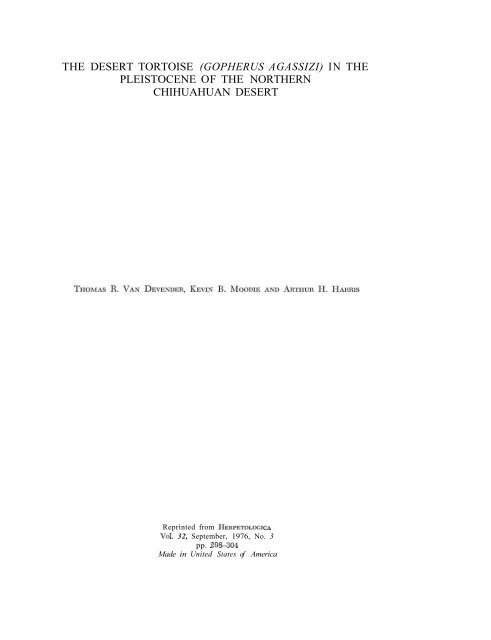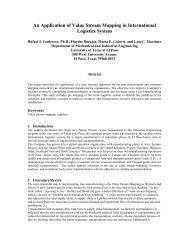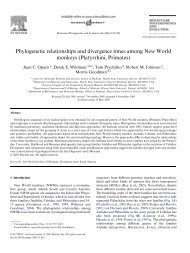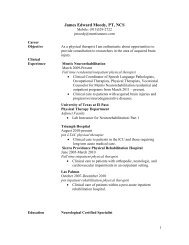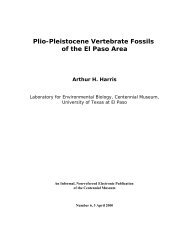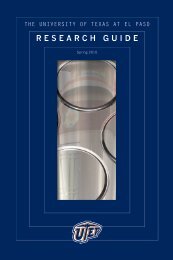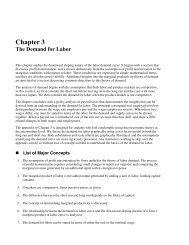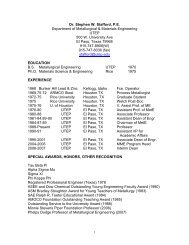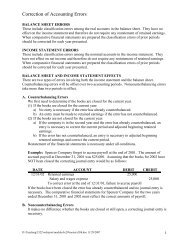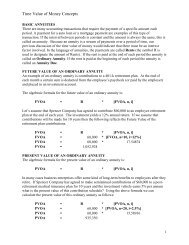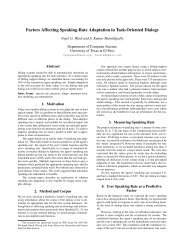THE DESERT TORTOISE (GOPHERUS AGASSIZI ... - ResearchGate
THE DESERT TORTOISE (GOPHERUS AGASSIZI ... - ResearchGate
THE DESERT TORTOISE (GOPHERUS AGASSIZI ... - ResearchGate
- No tags were found...
You also want an ePaper? Increase the reach of your titles
YUMPU automatically turns print PDFs into web optimized ePapers that Google loves.
<strong>THE</strong> <strong>DESERT</strong> <strong>TORTOISE</strong> (<strong>GOPHERUS</strong> <strong>AGASSIZI</strong>) IN <strong>THE</strong>PLEISTOCENE OF <strong>THE</strong> NOR<strong>THE</strong>RNCHIHUAHUAN <strong>DESERT</strong>Reprinted from HERPETOLOGICAVol. 32, September, 1976, No. 3pp. 298304Made in United States of America
<strong>THE</strong> <strong>DESERT</strong> <strong>TORTOISE</strong> (<strong>GOPHERUS</strong> <strong>AGASSIZI</strong>) IN <strong>THE</strong>PLEISTOCENE OF <strong>THE</strong> NOR<strong>THE</strong>RNCHIHUAHUAN <strong>DESERT</strong> 1ABSTRACT: New localities (Dry Cave and Robledo Cave) for late Pleistocene Gopherus agassiziin southeastern and south-central New Mexico, USA, are 350550 km east of the nearest modern populations.Plant community reconstructions from radiocarbon-dated fossil packrat middens from nearbyareas suggest that the tortoises were living in xerophilous woodland rather than the desert scrub habitatscommonly inhabited today. A paleoclimate with mild winters and cooler summers is postulated toexplain G. agassizi in the late Pleistocene of the northern Chihuahuan Desert.PLEISTOCENE faunas in the arid southwestand in the southern Great Plains have provideddramatic examples of animals havingdifferent geographic distributions underpluvial climates. Many of these are montaneforms such as the yellow-bellied marmot( Marmota flaviventris), the maskedshrew (Sorex cinereus), and the bushy-tailedpackrat (Neotoma cinerea) found as latePleistocene fossils at lower elevationsfarther south than they presently occur(Harris, 1970; Logan and Black, in press).'This paper is Contribution No. 679, Department ofGeosciences, University of Arizona, Tucson.HERPETOLOGICA 32:298-304. September 1976Others such as the least shrew (Cryptotisparva) and the box turtle (Terrapene carolina)formerly lived in southern NewMexico, but now occur no farther west thancentral and eastern Texas (Harris, et al.,1973; Milstead, 1967).Our purpose in this paper is to discussa different kind of distributional change.Brattstrom (1961, 1964) reported the deserttortoise (Gopherus agassixi) fromShelter and Conkling caves in southernNew Mexico. This is a xeric-adapted, desertspecies presently restricted to the low,hot Mohave and Sonoran deserts. However,this record indicates that during the
September 19761HERPETOLOGICAPleistocene and Holocene in age, consideringMartin's (1973; Long and Martin,1974) estimate of 11,000 years ago as thefinal extinction date for most of the megafauna.We have examined a complete plastronof Gopherus from Shelter Cave in theLos Angeles County Museum of NaturalHistory (LACM 1010/58912) and concurwith Brattstrom's identification of Gopherusagassizi.FIG. 1.-Map of the southwestern UnitedStates. Stippled area designates present distributionof Gopherus agussizi ( after Stebbins, 1966).RC = Robledo Cave, BC = Bishop's Cap (Shelterand Conkling caves), DC = Dry Cave.Pleistocene the species lived in higher,cooler areas in the present ChihuahuanDesert. Here we present new localities forG. agassizi in the northern ChihuahuanDesert (Fig. 1) and reconstruct its habitatusing plant macrofossil records from nearbyareas.Shelter and Conkling Caves.-Brattstrom's(1961, 1964) G. agassizi materialcame from two limestone caves at the southend of the Organ Mountains, Doña AnaCounty, New Mexico. The caves are locatedon the east (Conkling) and west(Shelter) sides of Bishop's Cap (= PyramidPeak of Brattstrom, 1964) at 1445-1475 m elevation. Bones of extinct mammals,including sloths (Nothrothriops andMegalonyx), horse (Equus) , Llama ( Tanupolama= Hemiauchenia of Webb 1974)and four-horned antelope (Tetrameryx)(Conkling 1932; Stock 1930, 1932), wereused to support early claims of the contemporaneityof man and Pleistocene fauna(Bryan, 1929). Some of the tortoise boneswere burned, suggesting that they wereeaten by the Indians, but these depositshave not been radiocarbon dated and theassociation of the fauna and man is notclear. The deposits are apparently lateRobledo CaveReferred Material.-Right hyoplastron( MALB 74-1) ; two peripheral bones( MALB 74-1,2).Gopherus remains were recovered fromRobledo Cave (MALB Loc. No. 74) in theRobledo Mountains northwest of LasCruces, Doña Ana County, New Mexico.This locality is = 65 km NNW of Bishop'sCap and is on the opposite side of the RioGrande Valley. Potsherds, charcoal, andbones (some burned) were found with thetortoise bones in a shallow, badly disturbeddeposit. No radiocarbon dates areavailable, but the tortoise material is wellpreservedand could be Pleistocene in age.Three different sized individuals are represented.The fragments are not identifiableto species, but probably represent G. agassizi.Dry CaveReferred material-Sabertooth CamelMaze (MALB Loc. No. 5): axial portionof right hyoplastron (MALB 5-111); rightxiphiplastron (MALB 5-110) ; right xiphiplastron( MALB 5-252) ; fragmentary nuchal(MALB 5-253); nuchal (MALB 5-109); Vanishing Floor Room (MALB Loc.Nos. 26 and 27): nearly complete shellmissing neurals (MALB 27-88); nuchal( MALB 26-243) ; left xiphiplastron ( MALB26-231 ) ; left xiphiplastron ( MALB 26-331).Dry Cave is located 24 km west of Carlsbad,Eddy County, New Mexico, on theeastern flanks of the Guadalupe Mountains(Harris, 1970). This site is - 175 km eastof Bishop's Cap and is the easternmost lo-
300 HERPETOLOGICA [Vol. 32, No. 3TABLE 1.-Radiocarbon dates and locality information of sites mentioned in text.ElevationSite Date (YBP) Lah. No. Material dated (m) LocationDry CaveSabertooth Camel Maze 25,160 -1- 1730 Tx-1775 Bone carbonateVanishing Floor Room 33,590 k 1500 Tx-1773 Bone carbonateWilliams Cave #2 Midden 12,040 -1- 210 A-1540 JuniperBishop's Cap #1 Midden 10,650 2 170 A-1571 JuniperBishop's Cap #2 Midden 10,780 -1- 240 A-1572 JuniperBishop's Cap #3 Midden 10,260 -1- 250 A-1573 Juniper1290 Eddy County,New Mexico1495 Culberson County,Texas1465 Doña Ana County,New Mexico1465 Doña Ana County,New Mexico1465 Doña Ana County,New Mexicocality for Pleistocene Gopherus agassizi.Two rooms in Dry Cave (SabertoothCamel Maze and Vanishing Floor Room)have yielded Gopherus fossils (Table 1).The best specimen is a nearly completeshell that we refer to G. agassizi on the followingclualitative and quantitative characters.The nuchal scute is wider thanlong (L/W = 0.93), a character given byWilliams (1950) for the genus Gopherus.In both the Dry Cave and Shelter Cavespecimens examined, the gular scutes areshorter than the humeral scutes along themidline of the pastron (G/H = 0.63 and0.61, respectively). G/H ratios < 1.0 arecharacteristic of the G. agassizi-group ( G.agassizi and G. berlandieri) rather thanthe G. p~l~~phemus-g rup (G. polyphemusand G. flavomurginatus; Legler and Webb,1961). This ratio in a series of 21 G. agassizifrom Arizona, California and Sonora,Mexico, in the University of Arizona Departmentof Biological Sciences HerpetologicalCollection (UAZ) ranged from0.40-0.90 with averages of 0.59 and 0.66for females and males, respectively. Thegular projection is relatively better developedin the G. agassizi group; the fossilshave gular projections very similar to G.agassizi. The shell in the Dry Cave fossilis oblong, longer than wide: carapaceL/W = 1.22; plastron L/W = 1.38. TheL/W ratio for the plastron is identical togreater than the average (1.25) or largestvalue (1.33) for a series of G. berlandieri(Carr, 1952). This ratio for the ShelterCave plastron is = 1.42. This ratio forthe UAZ series of 21 specimens was 1.40-1.65, mean 1.52. The Dry Cave shell wasfrom a female with a carapace length of252 mm (L/W = 1.22). This is larger thanthe maximum for G. berlandieri (219 mm,male; Auffenberg and Weaver, 1969), butwithin the range of 230-265 mm for sexuallymature females (males are larger)G. agassizi (Woodbury and Hardy 1948).The Shelter Cave plastron was also from afemale, but = 14% larger than the DryCave specimen. Tables 2 and 3 present themeasurements from all fossil specimens.Bone carbonates from Sabertooth CamelMaze and Vanishing Floor Room yieldedradiocarbon dates of 25,160 1730 (Tx-1775) and 33,590 2 1500 (Tx-1773), respectively.While dates on bone carbonateare not as reliable as those on wood orplant material, these dates serve to placethe fossils in the mid-Wisconsinan interstadialfrom 25,000-35,000 years ago.During the late Pleistocene, G. agassizilived in the northern Chihuahuan Desert insouth-central and southeastern New Mexico.The few records available suggestthat G. agassizi was present during themid-Wisconsinan interstadial and during-the average for a series of G. agassizi and -
Septembe~ 19761 HERPETOLOGICA 301TABLE 2.-Measurements (mm) of late Pleistocene Gopherus agassizi from Dry Cave, Eddy County,New Mexico. All specimens are in the Museum of Arid Land Biology, University of Texas at El Paso.Specimenno.Element27-88 Bones: epiplastronentoplastronhyoplastronhypoplastronxiphiplastronSutures: epi-hyoplastralhyo-hypoplastralhypo-xiphiplastralScutes: gularhumeralpectoralabdominalfemoralanalSulci: gulo-humeralhumero-pectoralpectoro-abdominalabdomino-femoralfemoro-analAnterior lobe of plastron:Posterior lobe of plastron:Gular notch:Anal notch:Nuchal scute:26-243 Nuchal: bonescute5-109 Nuchal: bonescute5-253 Nuchal: scute5-252 Right xiphiplastron: boneanal scuteanal notch5-110 Right xiphiplastron: boneanal scuteanal notch26-231 Left xiphiplastron: boneanal scuteanal notch" Estimate.** = Bone fragmentary.WidthMidlinelength Max Across alastronthe latest Wisconsinan of 10,000 to 12,000years ago. We do not know if G, agassizilived in the Chihuahuan Desert region duringthe full-glacial period of 18,000 to21,000 years ago, or if it survived into theHolocene.The plant macrofossil record of the latestWisconsinan preserved in ancient packrator woodrat (genus Neotom) middens inthe Chihuahuan Desert can help to recon-struct the Ice Age habitats of the deserttortoise. Three fossil packrat middens collectedfrom between Shelter and ConklingCaves on Bishop's Cap contain a record ofa very xerophilous woodland. Woodlandspecies that do not presently occur onBishop's Cap are juniper (Juniperus sp.)and netleaf hackberry ( Celtis reticulata) .A suite of other plant species were associatedwith them, but the xeric-adapted Chi-
302 HERPETOLOGICA Wol. 32. No. 3TABLE 3.-Measurements (mm) of late Pleistocene Gophemcs agassizi from Shelter Cave, Doiia AnaCounty, New Mexico. Specimen is in Los Angeles County Museum of Natural History (LACM1010/58912).WidthsSpecimenMidlineNo. Element length Max Across plastronLACM Bones: epiplastron1010/ entoplastron58912 hyoplastronhypoplastronxiphiplastronSutures: epi-hyoplastralhyo-hypoplastralhypo-xiphiplastralScutes: gularhumeralpectoralabdominalfemoralanalSulci: gulo-humeralhumero-pectoralpectoro-abdominalabdomino-femoralfemoro-analAnterior lobe of plastron:Posterior lobe of plastron:Gular notch:Anal notch:* = Estimatehuahuan Desert species, such as creosotebush( Larrea divaricata) and mariola(Parthenium incanum) were not found.Radiocarbon dates on juniper seeds andtwigs from the middens were 10,260 ? 250(A-1573), 10,650 k 170 (A-1571) and10,780 2 240 (A-1572) radiocarbon yearsago (YBP) (Table 1). This late Pleistoceneplant community is probably verysimilar to those at Shelter and Conklingcaves when the fossil Gagassizi were deposited.The late Pleistocene plant communitiesin the southern Guadalupe Mountains wererecently studied using plant macrofossilspreserved in a packrat midden and pollenpreserved in cave fill from Williams Cave(Van Devender, et al., in press). At 12,040& 210 YBP (A-1540, on juniper), thepaleocommunity was also a woodland, butwas relatively more mesic than Bishop'sCap. Besides juniper, Colorado pinyon(Pinus edulis), oak (Quercus sp.), and blackcherry ( Prunus serotina) were present.Williams Cave is 55 km SSW of Dry Cave(1330 m elevation) in Culberson County,Texas, at 1495 m elevation. Xerophilouswoodland probably extended to the lowestelevations (1075 m) in the valleys surroundingthe Guadalupe Mountains at thattime. Wells' (1966) study of fossil packratmiddens showed that xerophilous woodlandoccurred as low as 615 m in the BigBend of Texas 330 km south of the GuadalupeMountains, and probably coveredmost of Trans-Pecos Texas at higher elevations.Late Pleistocene Gopherus agassizilived in that woodland and could havebeen more widespread in the Trans-Pecosthan present records suggest. There areno plant macrofossil records for the mid-Wisconsinan interstadial, but the faunal recordsfrom Dry Cave imply temperaturesslightly more moderate than today withslightly more effective summer precipitation(Harris, 1970, in press). The vegeta-
September 19761 HERPETOLOGICA 303Ition may not have been greatly differentfrom the late Wisconsinan communities.Gopherus agmsizi is a species of the low,hot deserts in its present geographic range;it would rarely, if ever be found in a woodlandtoday. The eastern limits of its presentdistribution are near Benson, CochiseCounty, Arizona (Stebbins, 1966; Fig. 1).This is a transitional area where severalChihuahuan species, such as the Texashorned lizard (Phrynosoma cornutum) andtarbush ( Flourensia cernua) , reach theirwestern limits. Sonoran s~ecies reaching:their eastern limits incluie the saguari(Cereus giganteus) and the palo verde( Cercidium microphyllum) . The presentdistribution of Gopherus agassixi wouldsuggest that it is a cold-sensitive specieslimited by low winter temperatures to theeast. The Pleistocene localities for it are350 to 550 km farther east. The familiarclimatic reconstruction of winters similarto present ones or milder and with coolersummers may help to explain this record,i.e., harsh winters with very low temperatureswould kill tortoises even in their burrows;cooler summer temperatures wouldallow woodland plants to exist at lowerelevations. The extirpation of G. agassixifrom the Chihuahuan Desert is difficult toexplain climatically, because it presentlylives in habitats as hot and dry as the ChihuahuanDesert today. More severe wintersin the Holocene may have been involved,but we hesitate to infer this fromnegative evidence.Acknowledgments.-Ben Everitt, El Paso ArchaeologicalSociety, helped collect fossil packratmiddens and survey the modern vegetation ofBishop's Cap. Robert McKenzie, Los AngelesCounty Museum of Natural History, kindly loanedthe Shelter Cave Gopherus agassizi specimen.Cyndi Everitt, El Paso Archaeological Society,provided several important literature references.Betty Fink provided editorial assistance. AustinLong of the Isotope Geochemistry Laboratory,Department of Geosciences, University of Arizona,provided radiocarbon dates with support fromNSF Grant GB-27406 to Paul S. Martin, Departmentof Geosciences, University of Arizona. TheDry Cave investigations were supported by grantsfrom the National Geographic Society and theUniversity Research Institute, the University ofTexas at El Paso. Charles H. Lowe, Jr. and JohnK. Cross allowed us to examine modern Gopherusagassizi in the University of Arizona Departmentof Biological Sciences Herpetological Collection.AUFFENBERG, W. AND W. G. WEAVER, JR. 1969.Gopherus berlandieri in southeastern Texas.Bull. Florida State Mus., Biol. Sci. 13:141-203.BRATTSTROM, B. H. 1961. Some new fossil tortoisesfrom western North America with remarkson zoogeography and paleoecology of tortoises.J. Paleontol. 35:543-560.. 1964. Amphibians and reptiles fromcave deposits in south-central New Mexico.Bull. South. California Acad. Sci. 63:93-103.BRYAN, W. A. 1929. The recent bone-cavernfind at Bishop's Cap, New Mexico. Science70:3941.CARR, A. F., JR. 1952. Handbook of turtles.Comstock Publ. Assoc., Ithaca.CONKLING, R. P. 1932. Conkling Cavern: thediscoveries at Bishop's Cap, New Mexico. WestTexas Hist. Sci. Soc. Bull. 44:6-19.HARRIS, A. H. 1970. The Dry Cave mammalianfauna and late pluvial conditions in southeasternNew Mexico. Texas J. Sci. 22:3-27.. In press. Wisconsin age environmentsin the northern Chihuahuan Desert: evidencefrom the higher vertebrates. In: R. H. Wauerand D. H. Riskind [eds.] Transactions-symposiumon the biological resources of the ChihuahuanDesert region, U.S., and Mexico. U.S.National Park Service, Washington, D.C., R. A. SMAR~, AND W. R. SMARTT. 1973.Cryptotis parva from the Pleistocene of NewMexico. J. Mammal. 54:512-513.LEGLER, J. M., AND R. G. WEBB. 1961. Remarkson a collection of bolson tortoises, Gopherusflavomarginatus. Herpetologica 17:2637.LOGAN, L. E., AND C. C. BLACK. In press. TheQuaternary vertebrate fauna of Upper SlothCave, Guadalupe Mountains National Park,Texas. Symposiun~ volume on biological investigationsin the Guadalupe Mountains NationalPark, Texas. U.S. National Park Service,Washington, D. C.LONG, A., AND P. S. MARTIN. 1974. Death ofAmerican ground sloths. Science 186: 638-640.MARTIN, P. S. 1973. The discovery of America.Science 179:969-974.MILSTEAD, W. W. 1967. Fossil box turtles( Terrapene ) from central North America, andbox turtles of eastern Mexico. Copeia 1967:168-179.STEBBINS, R. C. 1966. A field guide to westernreptiles and amphibians. Houghton Mifflin Co.,Boston.
304 HERPETOLOGICA [Vol. 32, No. 3STOCK, C. 1930. Quaternary antelope remainsfrom a second cave in the Organ Mountains,New Mexico. Los Angeles Cty. Mus. Publ. 2:1-18.. 1932. A further study of the Quaternaryantelopes of Shelter Cave, New Mexico.Los Angeles Cty. Mus. Publ. 3:l-45.VAN DEVENDER, T. R., W. G. SPAULDING, ANDA. M. PHILLIPS, 111. In press. Late Pleistoceneplant communities in the Guadalupe Mountains,Culberson County, Texas. Symposium volumeon biological investigations in the GuadalupeMountains National Park, Texas. U.S. NationalPark Service, Washington, D. C.WEBB, S. D. 1974. Pleistocene llamas of Florida,with a brief review of the llami, p. 170-213. In: S. D. Webb [ed.] Pleistocene mammalsof Florida. Univ. Florida Press, Gainesville.WELLS, P. V. 1966. Late Pleistocene vegetationand degree of pluvial change in the ChihuahuanDesert. Science 153:970-975.WILLIAMS, E. E. 1950. Testudo cubensis andthe evolution of western hemisphere tortoises.Bull. Am. Mus. Nat. Hist. 95:l-36.WOODBURY, A. M., AND 11. HARDY. 1948. Studiesof the desert tortoise, Gophemcs agassizi. Ecol.Monogr. 18: 145-200.Received: 23 May 1975Accepted: 22 August 1975(TRVD and KBM) Department of Geosciences,University of Arizona, Tucson,Arizona 85721, USA, and (AHH) Museumof Arid Land Biology, University of Texas,El Paso, Texas 77968, USA


